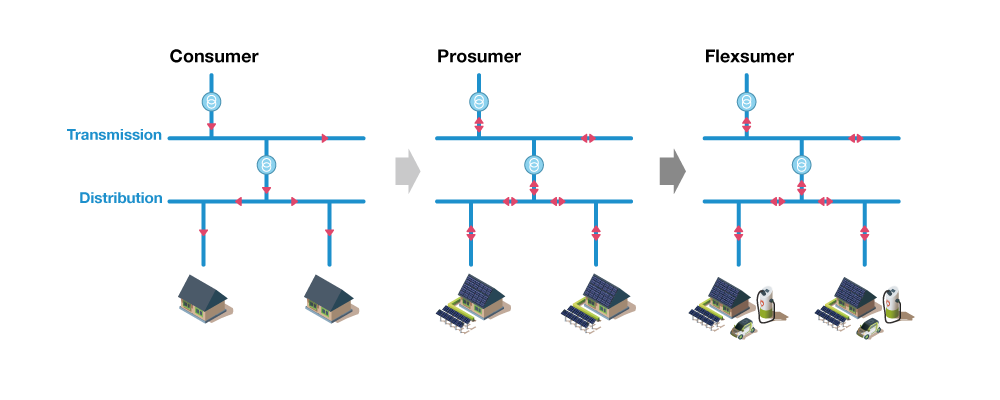Building a Community of Energy Flexsumers
Power grid operators can now take advantage of the growing use of renewable energy to make their grid greener. However, a greener grid is not necessarily a resilient grid. So, grid operators are always looking for ways to build a more resilient, reliable grid. One striking opportunity stems from the rise of residential photovoltaic (PV) systems in private households to generate electricity for their own use. For both PV households and the grid, the beauty of this trend is that the former can supply their surplus power to the latter.
Households that sell their surplus electricity to the grid, also called “prosumers,” can store excess electricity either in stationary batteries or the battery of their electric vehicle. Adding battery storage capability provides prosumers the flexibility to charge and discharge batteries according to their individual objectives. Thus, these “prosumers” have turned into “flexsumers,” as they optimize the usage of their batteries based solely on their own consumption and PV production needs.

For the time being, PV households cannot operate entirely independently from the power grid. In wintertime, the power grid must provide a residual amount of electrical energy to these households. During sunny periods, they can still sell excess energy to the grid.
What if they could trade this residual energy locally within the community? Would the power grid be under less strain from peak power injection during sunny days? Would all the residual energy be traded locally?
To answer these questions, a real-world research project called BASE.V was launched in Germany. According to Martin Jenkner, BASE.V project manager at Moxa Europe, this flexibility—made possible by pooling storage capabilities—also provides a valuable buffer to distribution grid congestion and bottlenecks during peak usage periods. As the networks of flexsumer households become more energy self-sufficient, they can contribute to energy resilience and grid stability without making a significant investment in grid capacity or infrastructure.
Putting Flexsumers to the Test in the Real World
Conducted by a research team from the Technical University of Munich and funded by a government grant and private sponsorships, BASE.V ran for six months. Seven households in the town of Dietfurt in Bavaria, Germany—each equipped with a PV system, stationary battery storage, and an electric car with a charging station—took part in the study.
Participating households could buy or sell electricity via a peer-to-peer trading platform. They executed Individual trading orders via smart contracts, which were processed through an Industrial Internet of Things (IIoT) gateway from network communications specialist Moxa.
The lessons learned from the BAVE.V project showed that electricity trading between individual households could help bridge the inherently fluctuating solar-energy generation and transiently rising electricity consumption, without jeopardizing grid stability.
Connecting the Building Blocks
A distributed ledger and data protection, made possible by blockchain technology, facilitate peer-to-peer energy trading. As trading parties, flexsumer households can execute blockchain-based smart contracts without the need of a trusted third party. For the BASE.V study, program data and customized data were recorded in blockchains as part of a secure, reliable, and scalable communication and data architecture, leveraging Moxa’s IIoT gateway.
Kyle Hsieh, Moxa’s IIoT and Blockchain network engineer, points out that building a suitable blockchain network was critical to the BASE.V project. Quorum, a permissioned blockchain network, was chosen as the project’s blockchain framework for its smaller footprint on the IIoT gateway to save system resources. As Moxa’s IIoT gateway allows containerization, developers can take advantage of a hybrid platform to deploy software on both cloud and edge platforms for platform-specific tasks. The same benefit applies to hybrid networks, as multiple network-specific applications are deployed on the same device.
For instance, Moxa’s IIoT gateway can handle blockchain nodes (so-called light nodes) to sync the trading transactions between households and the cloud. In addition, the EMS inside runs an optimization algorithm for predicting energy generation and consumption. Finally, an IoT client can help operators manage the IIoT gateway from the cloud throughout its life cycle. With this setup, the customers follow simple instructions to connect to the gateway. Virtual private networks (VPNs) easily support remote monitoring and troubleshooting, so on-site technical support visits are rarely necessary.

Regarding IIoT performance, Moxa’s developers were able to configure system resources to reduce the CPU processing time to suit the specifications of the BASE.V study. Energy trading is carried out in a 15-minute time slot. Hsieh explains, “Our first obstacle was reducing the computation time needed to run the optimization algorithm on the ARM-based computer. We finally improved it from 22 minutes to 22 seconds, thanks to the flexible configuration and powerful processors. Moxa’s IIoT gateways rose to the challenge of executing energy trading swiftly.”
A Closer Look at Our Communication and Data Solution
The BASE.V project is a forward-looking study that assesses whether providing economic incentives such as peer-to-peer renewable energy trading among prosumer households can promote energy self-sufficiency. The successful and widespread implementation of energy trading eases grid congestion, thus contributing to grid stability and energy resilience.
To learn more about how to enable efficient energy trading and management, watch the webinar recording for detailed presentations about the BASE.V project and the Moxa IIoT solutions used to achieve blockchain-based peer-to-peer energy trading.
Article Courtesy: Moxa








